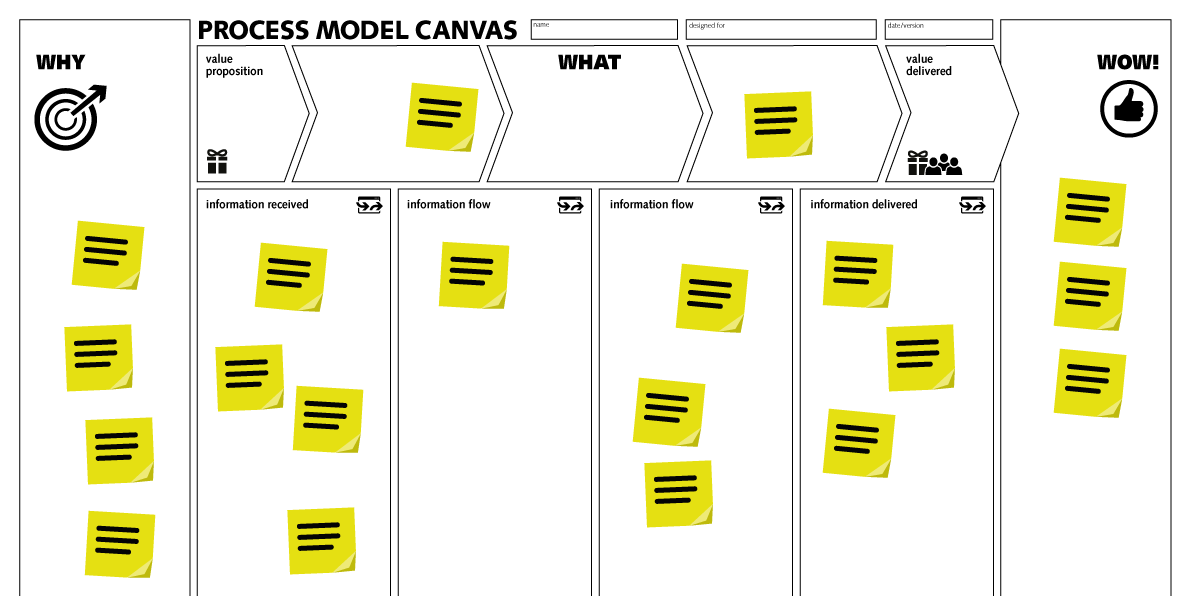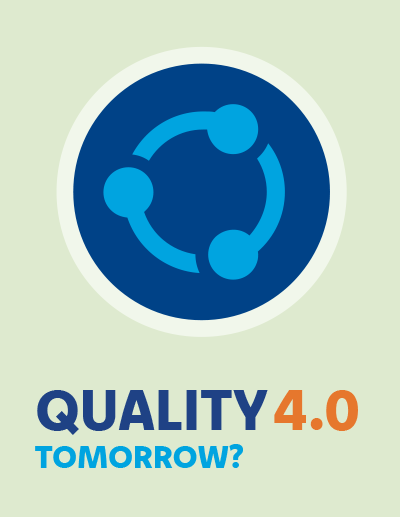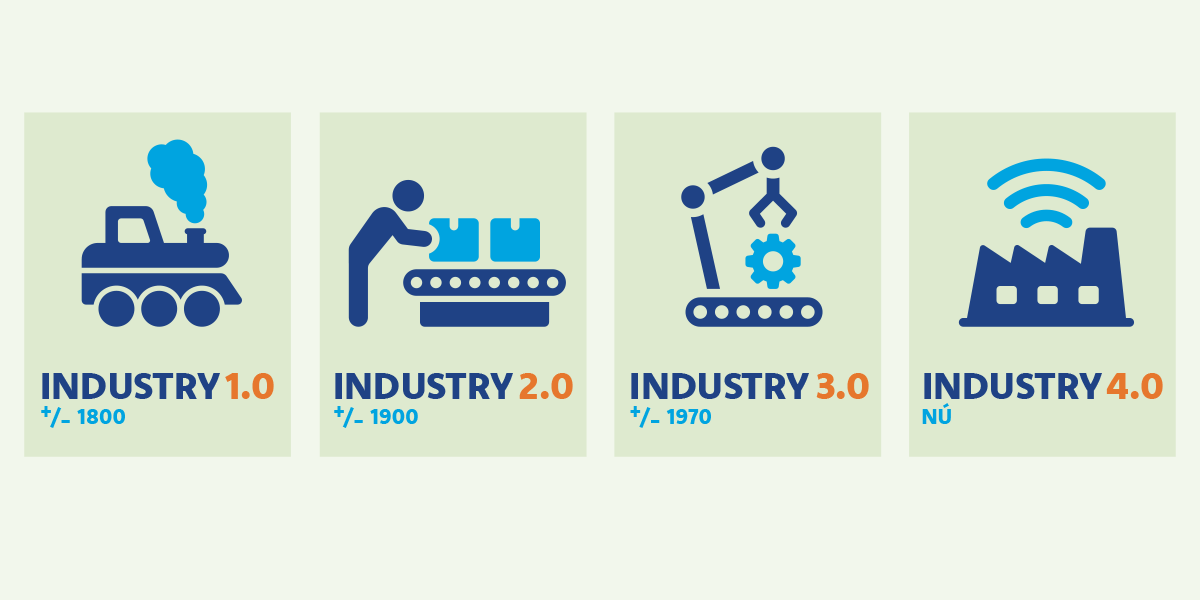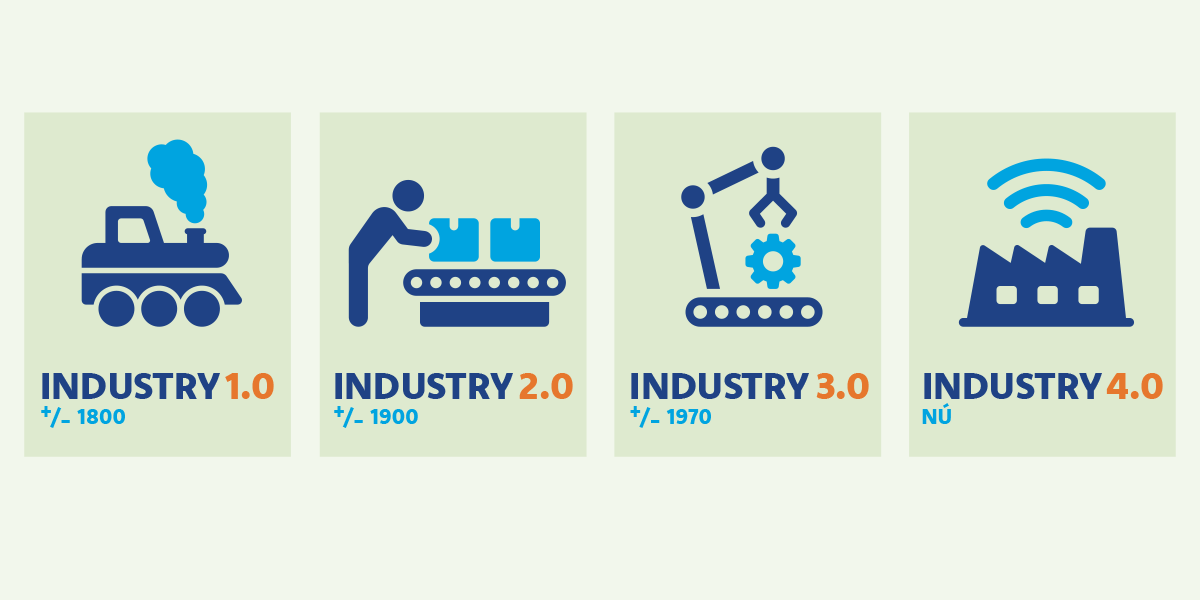Quality 4.0: what will it mean for your organization?
Industry 4.0, or the fourth industrial revolution, is in full swing. And with it comes Quality 4.0: a new era in quality management that will have a profound impact on organizations, of all sizes, that participate in the digital supply chain.
What is Quality 4.0, what does it mean for quality professionals and what are the benefits of implementing it? In this blog, we address these and other questions.
The following topics will be covered:
- What impact does Quality 4.0 have on quality professionals?
- Quality 4.0: the background and context
- What is meant by Quality 4.0?
- What are the benefits of implementing Quality 4.0?
- A smarter quality management system - how does it work?
- Finally: getting started with Quality 4.0
What impact does Quality 4.0 have on quality professionals?
Are you a quality professional or involved in quality management within your organization? We start this article with the key points affecting quality professionals getting started with Quality 4.0.
In the rest of the article, we explain various aspects of Quality 4.0 - from the background of Quality 4.0 to setting up a smarter quality management system.
Process analysis and the process landscape
The quality professional has the overview of the entire organization and its interconnections. By means of process analysis, you create a well-structured model and overview of the process landscape to serve all managers, specialists (QHSSE, IT, Control), team leaders and executive employees.
Above or through the departments and teams move information flows that connect the business processes. People from different departments thus learn to understand that they are implementing a process or complete process chain together.
People in departments can rarely make that analysis, which is why the quality professional makes sure that in process teams this essential basis of the process landscape is understood and maintained. That's where the first leads lie - the information flows for Quality 4.0. That data is the gold we are looking for.
Data analysis is becoming a key skill
As a quality professional, it is increasingly important to be able to handle, understand, correlate and analyze large amounts of data of various kinds and magnitudes yourself. Not only to be able to present these analyses on the meaning and coherence in a clear way, but also to be able to use them to improve your own performance.
Even if you are already working with data analysts or data scientists within your organization, it is advisable to learn more about this yourself. For example, by taking a course in data analysis and machine learning.
After all, a data scientist does not have the knowledge and experience in quality management and process management that you do as a quality professional. By being familiar with the definitions, methods and techniques, you can collaborate much more efficiently and effectively with fellow and external data scientists.
Algorithms become part of quality management
Algorithms are increasingly influencing the quality of a product or process in many Industries. It is therefore important for quality professionals to understand how these algorithms work and how they can be used within the organization.
You do not have to become a programmer, but it is important to understand the basics, impact and risks of algorithms. You will work on how the model is developed, trained, evaluated and calibrated, you will arrange for people to take care of "the demonstrable quality of the algorithms.
We like to explain this with a brief example.
In the automotive industry, it is important that the right parts get to the right place on time during assembly. Algorithms can help with this by making predictions about which parts will arrive at what time and where they should be stored until assembly. However, if there is a glitch or error in the algorithm, the wrong products may arrive at the assembly station at certain times. Thus, as a quality professional, it is important in this to understand the role of algorithms and how they can affect processes.
Closer collaboration with the IT department
The increasing use of data, sensors and artificial intelligence also has implications for collaboration within your organization. The separation between different departments is becoming increasingly blurred.
As a quality professional, you will therefore have to work more closely with colleagues from the IT department, for example. After all, they often have the necessary technical knowledge to support you. In this way, you create more balance in the disciplines that together determine how the work or processes are organized and digitized.
Communicate, communicate, communicate
Good communication with all stakeholders, internal and external, is now more important than ever before. To maximize the benefits of Quality 4.0, participation and acceptance from all stakeholders is essential. This requires a common language and process model that everyone understands and makes the essence of information flows visible.
Why? The success of Quality 4.0 depends heavily on data collection and analysis. Not only from a technical point of view, but also from a social point of view. If colleagues are not willing to capture and share data or do not trust the quality of the data collected, the success of Quality 4.0 will be limited.
Therefore, as a quality professional, it is important that you take the lead in this and ensure good communication with all stakeholders. In this, be aware that everyone is becoming: it's about a balance between leadership and teamwork.
Ask questions and make people think: What is our interest and what is your interest when we have steering information with a predictive value? Then we can save time and unnecessary costs of recovering from misses because we can better anticipate and optimize.
Quality 4.0: background and context
What is Industry 4.0?
Quality 4.0 has its origins in Industry 4.0. So before we dive into quality management and quality management, let's give a brief overview of the fourth industrial revolution.
- Industry 1.0: The first industrial revolution (late 18th century) was driven by power and mechanization.
- Industry 2.0: The second industrial revolution (late 19th century) was powered by electricity, oil and gas. This led to mass production with assembly lines.
- Industry 3.0: The third industrial revolution (late 20th century) was driven by computers and automation. The Internet played an important role in this.
- Industry 4.0: The fourth industrial revolution is driven by networks, data and smart technologies for analysis and prediction based on machine learning.
The term "Industry 4.0" was first used in 2011, when the German government shared a new industrial policy called Industry 4.0. The term subsequently gained popularity.
The goal of Industry 4.0 is to create a fully connected and flexible value chain. This means that all processes in the chain are connected and can communicate with each other. This allows companies to respond quickly and flexibly to changes in customer demand. Industry 4.0 thus leads to a completely new level of customer orientation and personalization.
Supply Chain integration
Within Industry 4.0, among other things, there is an emphasis on integration and automation of processes in the supply chain. By integration, we mean that in an ideal situation the systems of suppliers, manufacturers and customers are all connected and can communicate seamlessly with each other. This enables efficient production planning and faster response to changes in customer demand.
Automation of processes has been boosted considerably by the emergence of several new technologies and techniques in recent decades. Since some of these also play a crucial role within Quality 4.0, we will explain them below.
Internet of Things (IoT)
With IoT, objects become "interconnected." Simply put, normal devices receive an additional technological upgrade, making them proactive sensors and actors in an increasingly intelligent network. Through the Internet, these devices are then linked to communicate and interact with each other.
Consider, for example, a smart, or rather, watchful refrigerator that can communicate with a supermarket's systems to automatically order new products when they are running low.
IoT can also be applied on a much larger scale. For example, an entire factory can be connected via IoT. This enables efficient communication and data exchange between machines and with process control systems, as well as the ability to remotely monitor production processes and adjust them automatically or not.
Big Data
Big Data refers to large sets of structured or unstructured data that can provide valuable insights when analyzed with the right software and tools.
For example, this data can be collected through the sensors in IoT devices. The collected data is then analyzed and turned into information that can be used to improve processes. Not only internal data, but also data about customers, suppliers and other external stakeholders can be used.
Artificial Intelligence (AI)
Another development that we are now seeing especially in Industry 4.0 is the power of integrating artificial intelligence. With artificial intelligence, machines are taught to recognize patterns. As a result, they develop predictive capabilities and systems can also make decisions independently whenever possible. Devices become more efficient, better understand their context and even become self-learning based on previous experience.
Examples of Artificial Intelligence applications include:
- Automatic detection of manufacturing defects
- Optimizing production volume and speed of chains
- Predictive maintenance (so you can take action before a machine fails, and not too soon when it is still working fine)
- Route planning in internal logistics and transportation
Cloud Computing
Cloud computing has allowed companies to keep their data secure, organized and in real-time in one central location. A shared cloud system within a company allows employees from different departments to share, analyze and edit data at the same time. For example, information and the processes where it is used can be made clear and accessible using a cloud-based management system, such as Comm'ant.
The impact of Industry 4.0 on quality management
What does this all mean for quality management and optimizing product quality and process quality? Quality management is becoming smarter and more efficient through the integration of various technologies and techniques. Quality control can be partially automated, data can be collected and analyzed in real-time, and processes can be continuously improved using insights from this information. Predictive capabilities about product and process quality emerge to anticipate and proactively make interventions that contribute to optimal performance.
As a result, the standards of quality and production become much higher, as well as more consistent. In other words, quality management is also entering a new era: Quality 4.0.
What's meant by Quality 4.0?
Quality management focuses on the analysis and improvement of daily processes in companies. Since quality management plays such a significant role in the performance of organizations, it was only a matter of time that Quality 4.0 would emerge from Industry 4.0.
Within Quality 4.0, techniques such as data analytics, cloud computing and artificial intelligence or machine learning are deployed for quality management. This makes quality management more efficient, smarter, more flexible/agile, self-predicting and ultimately more reliable (less dependent on human vulnerabilities and errors).
The complexity of data and correlations between that data is beyond human comprehension. Whereas software systems do have that ability and in collaboration with humans who can oversee the situation. Systems provide essential input for monitoring, controlling and taking action to correct or preferably prevent deviations and errors.
So what are the values of these techniques within Quality 4.0?
Quality 4.0 & Data-Analysis
We touched on it a moment ago - as machines become more sophisticated and smarter, they can also collect valuable data. Implementing data collection and exchange gives you big data as a company that you can work with. This can be used within quality management in a variety of ways.
Process analysis
By analyzing this data, you can gain a better understanding of your business processes. For example, for the timely maintenance of a machine that often produces below quality, or identify errors more quickly that recur repeatedly during production. And also by using process mining to discover the optimal route of an order going through the company, what deviations occur and why.
Product analysis
This data can also be used to assess the final product. If your process is already well mapped out, you've come a long way. By also (partially) automating your product quality check, you will need less human inspection (which, after all, can be prone to subjectivity and inattention).
The ultimate lifecycle of your product is also demonstrably improved through quality improvements, giving you insights to make smart design choices and optimize the value of your product.
Stakeholder satisfaction
Finally, data analysis is useful not only internally, but also for maintaining stakeholder relationships. By creating and sharing insightful data analysis with stakeholders, you ensure higher stakeholder participation. How does the buyer and user of your product or service experience the quality of what you deliver and how you deliver it? How is the collaboration and quality of the relationship with all suppliers? With quality 4.0 approach, you can take that faster to the beginning of the process chain or that place where improvement opportunities have been reported.
Quality 4.0 & Cloud computing
With cloud computing, it's mainly about structurally concentrating data and information. When colleagues from different departments in your company have access to that cloud, the overview and insights, it helps create support in your quality management.
After all, the data is no longer "stuck" in a particular department, but can be used flexibly. A major benefit of this is that you become much more flexible and agile as a company. As a quality professional, you can now work with (almost) real-time data, which makes the work a lot more efficient. The knowledge required to deal with this effectively can be found in the combined fields of process management, quality management and data science.
Quality 4.0 & Artificial Intelligence (AI)
Artificial intelligence is used in Quality 4.0 primarily for two purposes:
- To support humans in analyzing and making decisions about data; and
- To automate processes with adaptive and learning capabilities.
This involves increasing insights, increasing the quality of actions and decisions, efficiency, consistency in applying knowledge and insights, and optimization of processes.
In decision support, artificial intelligence makes it easier for people to find the right information in big data. After all, it can be challenging, if not impossible, to manually sift through all that data to find what you're looking for.
Artificial intelligence can also be used to automate processes. For example, that a product is rejected with advancing insight because it will not meet quality requirements, the software can automatically redirect that product to another process for timely repair work and less waste.
What are the benefits of implementing Quality 4.0?
Quality 4.0 may sound like a hefty investment, but the benefits are worth it: after all, it improves your company's performance AND it offers more security.
1) Performance
As briefly mentioned earlier, it is a good investment for your company's performance. After all, quality management will become more effective, faster and more efficient, and there will be less chance of failure costs.
Less focus needed on the small problems
After all, these are detected automatically, and if human intervention is needed, it can be resolved in real time. As a result, you improve responsiveness and recovery and reduce down-time.
The quality is more accurate and improved
If the check is done by sampling and manually, it is only 80% accurate. In a "human check" there is always some subjectivity, and activities and processes can also be forgotten. With Quality 4.0, compliance with quality standards will be partially automated, where you as a quality manager will focus your energy on the more complex cases. As a result, monitoring will be more intense and accurate.
Transparency builds reputation and trust
By better mapping the facts & figures of your company and sharing them with stakeholders, they also get the insight of how they are connected and which and interdependencies affect the quality of the end result for the customer. This builds your reputation and participation as a company and allows you to include stakeholders in the transition to Quality 4.0.
2) Assurance
When the quality management system in your company is more accurate and real-time due to learning, you can also trust it more. Through Quality 4.0 implementation, you will soon find that micro-processes in your business chain will require little to no attention from human intervention. This allows you as a company to focus on the bigger issues and strategic decisions.
A smarter quality management system - how does it work?
Now that you understand the benefits, it might be a good time to look at your own quality management system. How can you make it smarter?
Technically
At the technical level, making your quality management system smarter will require a lot of work. It requires an understanding of techniques and information such as cloud computing, artificial intelligence and big data.
Implementing IoT in the machines within your supply chain will generate a lot of data. You need data scientists who can interpret this big data and translate it into an understandable representation of performance and trends for management, which also correlates with process performance goals and the quality of the relationship with stakeholders. This applies not only to your quality management, but also to all other stakeholders in your business chain.
The big picture
The basis of any smart quality management system is to map and describe all business processes. Despite the fact that proper implementation of Quality 4.0 depends on microscopic performance, you must first zoom out to the big picture.
Process description
Describing a process is complex because of all the elements involved. When you use a systematic input/output process chain model you simplify the complex and it becomes structured. In the structured model you can zoom in and there is a logical relationship between the elements. This makes it possible to understand the process and its interdependencies.

Before you put the process description in a management software, the main thing you need to do is to get the basic structure right. Describing a process in a structured way can be done successfully with the Process Model Canvas (PMC).
Structuring and standardizing
When you describe the process you will see many data elements recurring more often, such as customer requirements, product requirements, process requirements, critical performance indicators, risks, deviations, etc.
Without structure, these elements are floating and meaningless; you don't really know how and where it affects them. If you structure and map the process properly, you will gain insight into where your data sources are and where those information flows should go. The process model is the coat rack or baseboard, so to speak. You thereby create the basic infrastructure where the information systems are at work, where the standardized data elements are defined and connections between those systems become transparent. The output of one process is literally input to another process. What systems are used there to capture, process and transmit data.
Digitization
When the whole picture is complete and the process is clear and streamlined, you can digitize it optimally. Partly in production automation and partly in the continuous improvement of product and process. The process quality forms the basis for your product quality. You can do this using quality management software from Commant. This is where Quality 4.0 really begins. Soon you will notice the benefits of process digitization and see the results inside and outside your organization.
A well-oiled machine
More will be asked of quality professionals in terms of strategic creativity and flexibility.
With a real-time data-driven quality management system, quality professionals will have to be flexible in responding to abrupt changes, also known as agile organizing. Adjusting the process on the spot for better path and handling.
Using convenient quality management software that makes all information accessible through one hub makes it easier for quality professionals to make the right decisions and quickly adjust and share your process agreements. This is where Comm'ant's software can come in handy.
Getting started with Quality 4.0

Now that you know all about Quality 4.0 and how it can affect your company's quality system, you can get started with implementation. Since Quality 4.0 can have a big impact on your business processes, it's important to do it step by step. We have 3 tips to make this easier.
#1 Quality 4.0 is part of the bigger picture
Industry 4.0 and Quality 4.0 and other 4.0s are all connected and intertwined. It is important to know that these cannot work in isolation from each other. There is a connecting factor, though, and that is the business processes and information flows that you deploy as an "agile process engineer" to make the organization aware of this connection.
Without implementing IoT in your business chain, you won't be able to generate data. So then you won't have data for your quality management system. So start with the big story, the processes with inputs/outputs & systems and the data sources located therein.
Where in your company can you meaningfully apply and implement Industry 4.0 technologies? What does this mean for your process management standards? And ultimately, how does this translate to a quality management system?
#2 Teamwork makes the dream work
Train your entire organization and stakeholders on Industry & Quality 4.0. When you are a quality manager specializing in Quality 4.0, you have only taken the first step.
The implementation will still not be effective if the rest of the company and your stakeholders are not on board. It is important to increase the acceptance rate of Industry 4.0 and Quality 4.0 within and outside your company.
#3 Keeping the objective in mind
Quality 4.0 is a big task and requires time and patience. Therefore, be aware that Quality 4.0 does not change the meaning of quality management. The theory will remain essentially the same. Only the implementation will change with the advent of data and algorithms.
Really getting started with Quality 4.0 now? Above all, contact our process and quality experts to find out how your Comm'ant quality management software can help you do this.




